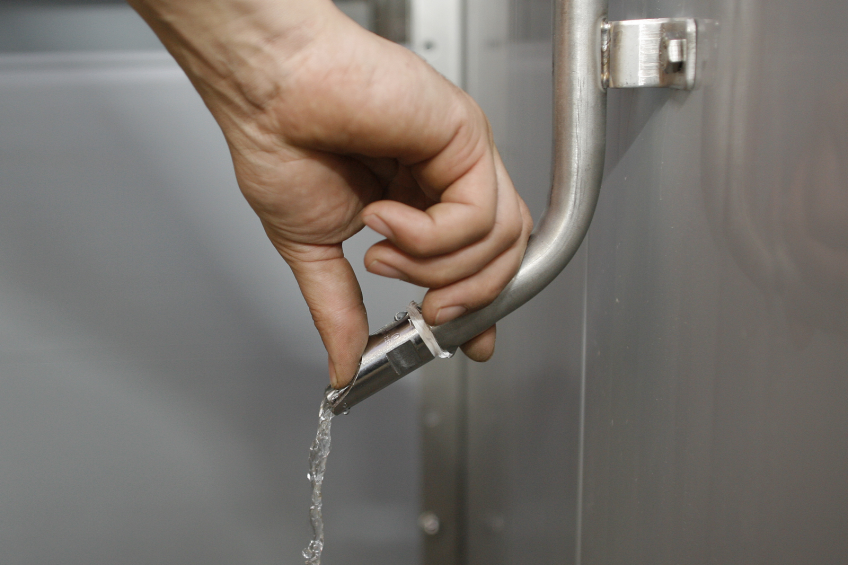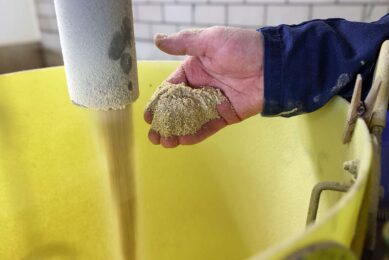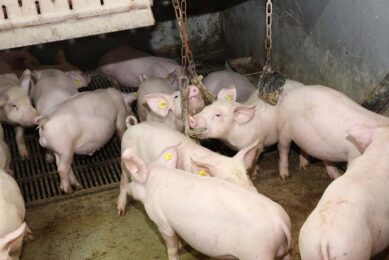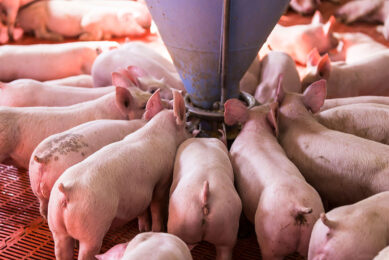Saving water without compromising pig welfare

With water it is the same as with many other aspects of pig production: measuring is ?knowing. Only true knowledge of the do’s and don’ts of water consumption can help save water usage and improve production as well.
By Prof Peter Brooks, United Kingdom
Water used to be considered an inexpensive resource in pig production. However, this is not the case for all production units. Good quality drinking water, essential for optimum productivity, can be in short supply in many parts of the world and/or expensive to provide. Producers also express concern about the volume of effluent being produced on their units, because of both the cost of storing, transporting and spreading effluent and the potential environmental impact of that effluent. These concerns about effluent volume can lead producers to attempt to reduce what they perceive to be ‘wastage’ of water by their pigs. Unfortunately, in some cases the actions that they take can compromise both pig performance and pig welfare. This article looks at some approaches to water demand management that maintain pig performance and protect pig welfare.
Effluent volume
Pigs fed ad lib will not over-consume water, but they may spill it. Pigs have a finite ‘volumetric fill’ capacity. There is a physical limit to how much food and water they can take into the body. The pig’s homeostatic control mechanisms will attempt to maximise the amount of feed and minimise the amount of water within that ‘volumetric fill’ capacity. If pigs are rationed (e.g. pregnant sows) they may take additional water to satisfy their need for gut fill. The need for gut fill is better satisfied by providing a more bulky (less nutrient-dense) diet, or bedding, that allows them to achieve satiety without using additional water for gut fill.
With some problem groups of pigs, like weaners and lactating sows, it is necessary to do everything that is possible to stimulate water consumption in order to improve performance. In the case of weaners their consumption of food may be restricted by their unwillingness to drink. When they drink more, they eat more and grow more.
Water spillage (wastage) does increase effluent volume but does not necessarily increase the environmental impact of the unit as it simply dilutes the nutrients that are going into the effluent. Before making changes aimed at reducing wastage by the pigs it is worth conducting an audit to see what other sources of water are entering the effluent storage. Some of these may be more easily and cost effectively corrected. The design and operation of many units’ means that changes aimed at reducing water demand by the pigs will have only a modest impact compared with other interventions.
- Look at effluent storage on the unit. Units around the world still have open effluent storage tanks or lagoons. Consequently, rain water falling on the lagoon can make a significant contribution to the total effluent volume. If the effluent storage is covered check whether rain water from roofs and surface water from the unit are put into the effluent storage.
- In hot climates water drippers and sprinklers are often used to cool pigs. It is well worth investing in a water meter to check the amount of water these contribute to the slurry. Water used for cooling pigs is essential and protects there welfare, but sprinklers operating in empty pens, or even empty buildings, and when the temperature does not warrant there use waste water and increase effluent volume.
- Finally, it is rare to find units where wash water from buildings is diverted to a separate containment from the pig slurry. Indeed on most units this is not possible. The water used to pressure-wash buildings can be considerable and in nurseries can even exceed the amount of water used by the pigs. If producers have to buy water, it is worth considering how quickly they could pay off the investment in rain water harvesting.
A problem or an asset?
Years ago animal excreta was always considered an asset not a problem. Its manurial value was recognised and valued. If effluent is particularly dilute it is worth looking for alternative opportunities for its use where the irrigation value of the effluent has at least as much value as the nutrients it contains. So if all the issues above are addressed and still there’s the need to try to reduce water use by the pigs, where to start?
In a previous article (Pig Progress 30.07) I described the many functions that water fulfils for the pig. Briefly, in addition to its role as a nutrient, water is used to maintain body homeostasis, for detoxification, for temperature control, and to achieve satiety. It follows that we can reduce water demand if we can reduce the extent to which the pig needs to use water for these non-nutritional functions. The challenge is that all the strategies to reduce water demand have a financial cost and it is important to assess whether there is a real cost/benefit in implementing these strategies.
Diet composition
Water makes up around 70% of the lean adult pig, with some tissues containing up to 90% water. Consequently, each kg of gain will involve the retention of around 700 g water in the body. Additional water is then needed to facilitate the digestion, absorption and metabolism of nutrients in the diet that are used in maintenance, tissue growth and lactation. The greatest demand for water is for the metabolism of protein. There is a vast array of different proteins in the body but the most significant in this discussion are the proteins the pig deposits in tissue and secretes in milk.
When the pig ingests dietary protein this is broken down into peptides and the their component amino acids in the gut. These are then transported across the gut wall, carried in the blood and eventually rebuilt into body proteins. Amino acids that have not been used for the formation of body proteins are broken down by the body and the nitrogen from them is removed by the kidneys in the urine. The kidneys are only able to concentrate waste products in the urine up to a point. Once the maximum concentration has been reached the pig has to take in additional water in order to remove further waste products.
It is impossible to provide a quantity and quality (amino acid balance) of protein that is a perfect match for the body proteins being formed, so there will always be some nitrogen that needs to be excreted. The data in Figure 1 illustrates this. In this study, 20 kg pigs were fed to scale, on diets containing 21 to 27% crude protein. Water intake was measured and related to the intake of crude protein. The results show two distinct relationships. At the lower crude protein intakes, the requirement of the pigs had not been satisfied. Consequently, the amount of nitrogen that needed to be excreted reflected the amino acids that could not be utilised and this determined the amount of water the pigs consumed. Had the amino acid balance of the diet been closer to that of ‘ideal protein’ there would have been less amino acids to deaminate and excrete and the slope of the line would have been less. Conversely, if the amino acid balance in the diet had been worse, the slope of the line would have been greater. Once the protein requirement of the pigs had been satisfied, water intake increased. This is because once the requirement for essential amino acids has been met all the extra protein consumed has to be deaminated and excreted and this requires considerably more water.
In practical terms the increased demand for water can be considerable. In a recent study (Table 1) water consumption and the water:feed ratio were similar for diets containing 21.4% protein or 17.8% protein supplemented with essential amino acids to the same level as in the 21.4% diet. However, a 25.4% protein diet containing sufficient additional amino acids to support 50% greater growth increased water demand by 26.5%.
Water is also essential for the renal clearance of excess mineral intakes. Excesses of sodium, chloride and potassium ions all increase the demand for water. Increasing the salt concentration in the diet increases the demand for water. The sodium and chloride ions each affect water demand. When the sodium and chloride concentrations were varied independently of one another it was found that doubling the concentration of sodium in the diet increased the water:feed ratio by a staggering 82%. Potassium concentration in the diet also affected water demand but was not to the same extent as sodium.
It is clear that constraining the nutrient content of the diet to prevent oversupply of protein and minerals can have a significant effect on water demand. However, constraining the diet formulation more tightly will add cost. A careful cost:benefit analysis is essential.
Drinker choice
Producers are faced with many choices when installing drinkers. The type, number, flow rate, positioning and maintenance of drinkers can all affect their operation and the incidence of wastage. Some years ago a number of different drinkers was compared under the same conditions with surprising results. In these studies the pigs had continuous access to the drinkers and they were all installed according the manufacturer’s recommendations. There was no significant difference in growth performance of the pigs, so it is safe to assume that none of the drinkers imposed any restriction on water consumption. Therefore, it was concluded that the difference between the best and worst drinkers was due to wastage. It was amazing to find that the worst drinkers used 70% more water than the best. Multiplied up on a large unit this represented a considerable cost.
Water wastage
Wastage comes from a number of
sources, primarily from:
• Leakage when the pig is not using the drinker;
• Spillage when the pig uses the drinker;
• Wastage due to the drinker being operated for non-drinking purposes e.g. pigs rubbing against, or playing with, the drinker.
Leakage is a function of the design of the water delivery system and of drinker design and maintenance. It is nothing to do with the pig. Poor design may result in drinkers performing very differently at different water pressures. Most pig units use small diameter pipes throughout their delivery systems and these have to be operated at high pressure to ensure water reaches the far end of the supply lines. Even at high pressure there can be significant pressure loss along the length of a large house which results in very different pressures at the drinkers. Ideally, units should have just the opposite, namely large diameter supply pipes operated at low pressure. The main supply pipes in the building should be large diameter but downpipes into the pen can still be conventional small bore pipe. This configuration will reduce pressure at the drinker while maintaining a consistent flow from the drinkers in all the pens. It may not be an attractive proposition to change the supply pipelines in existing buildings but it should be considered when buildings are built or refurbished.
Routine checking and maintenance of drinkers can reduce losses due to leakage. Poorly designed drinkers are also susceptible to sand and other physical contaminants in the water delivery system causing them to leak.
Spillage is generally a result of three factors, poor design, incorrect flow rate (or water pressure), or incorrect height. It is worth observing pigs drinking. Many pigs do not use drinkers in the way the designer envisaged. They frequently take nipple and bite drinkers in the side of their mouth rather than the front and then spill considerable amounts of water. This problem is exacerbated if the water pressure is too high. The pig will deliberately hold the drinker in such a way that it does not get a forceful jet of water in the back of its throat. An example of the effect of water flow rate on water intake and water wastage is given in Figure 2. Recommended flow rates for different classes of pig are given in Table 2. A number of studies have shown that drinking bowls or cups are less wasteful than nipple or bite drinkers. However, unless they are well managed water quality can suffer.
Considering the impact that they can have on wastage, it is surprising that so few units fit drinkers on height adjustable brackets. Studies at the Prairie Swine Centre showed that adjusting the height of drinkers reduced wastage by around 9% units in grower pigs and 16% units in finishers. The savings were much greater when drinkers had higher flow rates. See Table 3 for recommended heights for drinkers.
The final aspect of wastage is inadvertent operation of the drinkers and play. Correct positioning of the drinker in the pen can reduce inadvertent operation. Fitting wings to protect the drinker can have three beneficial effects. First, it can reduce accidental operation by pigs rubbing against the drinker. Secondly, it can position the pig correctly so that it takes the drinker into its mouth at the correct angle and reduces spillage. Thirdly, if the wings are long enough to prevent the pig from seeing other pigs it can reduce displacement of the pig from the drinker by other pigs. A considerable portion of water wasted occurs at the start and end of the drinking bout. Therefore, if there are fewer drinking bouts because pigs are being displaced less at the drinker wastage will be reduced. Pigs can be discouraged from ‘playing’ with drinkers by environmental enrichment. The provision of toys or manipulable substrates (a requirement of Welfare Codes and of Quality Assurance in some countries).
Take home message
Producers are almost certainly wasting some water, but how much? It is important to not make changes based on guesswork, find out the facts and undertake proper cost-benefit analyses before making changes. PP
 Beheer
Beheer








 WP Admin
WP Admin  Bewerk bericht
Bewerk bericht